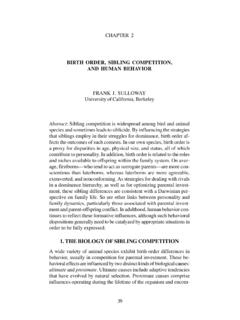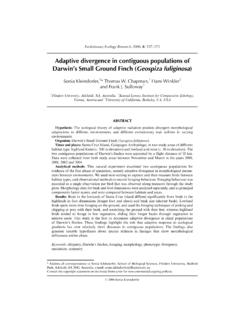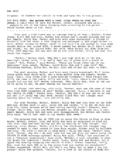Transcription of Darwin and his finches: The evolution of a legend
1 Darwin and His Finches: The evolution of a legend FRANK J. SULLOWAY Department of Psychologv and Social Relations Harvard University Cambridge, Massachusetts 02138 First collected by Charles Darwin in the Galapagos Archipelago, the Geospizinae, or Darwin s finches, have rightly been celebrated as a classic instance of the workings of evolution through natural selection. Among birds, Darwin s finches are rivaled only by the Hawaiian honey- creepers (Drepanididae) as a microcosmic exemplification of the princi- ple of adaptive evolutionary radiation. Although the Drepanididae have undergone more evolution and adaptive radiation than the Geospizlnae, the latter are in some ways more valuable to ornithologists.
2 Their special interest today, writes David Lack, is in providing the best example, in birds, of an adaptive radiation into different ecological niches that is sufficiently recent, geologically speaking, for intermediate and transitional forms to have survived (1964: 178). The Galapagos Archipelago, where Darwin spent five weeks collect- ing these finches during the voyage of Beagle (1831-1836), comprises sixteen principal islands located on the equator some six hundred miles west of Ecuador (Fig. 1). The islands, most of which are several million years old, are wholly volcanic in origin and have never been connected to the mainland.
3 Darwin s finches were evidently one of the earliest colonists of the Galapagos, since their degree of evolutionary complexity - thirteen species distributed among four genera - is unmatched by any other avian group in this archipelago. A fourteenth species, belonging to yet another genus, inhabits Cocos Island, four hundred miles to the northeast. Unlike other endemic species of Galapagos birds, the Geospizinae no longer have any close relatives on the American mainland. They are therefore classed in their own separate tribe or subfamily, which is placed with the Emberizidae.
4 Being one of the earliest colonists of the Galapagos Islands, the ancestral form of Darwin s finches found an environment in which the types of niches occupied by other, diverse birds on the continent 1. Darwin s finches have been the subject of numerous systematic treatments, of which the most important are by Gould (1837a, 1841, 1843), Salvin (1876), Ridway (1890,1897), Rothschild and Hartert (1899,1902), Snodgrass and Heller Journal of the History ofBiology, vol. 15, no. 1 (Spring 1982), pp. 1-53. 0022~5010/82/0151/0001 $ Copyright 0 1982 by D. Reidel Publishing Co., Dordrecht, Holland, and Boston, FRANK J.
5 SULLOWAY ALBEMRLE 1. I N c B MINGDON 1.. CHARLESI -+ * rIGABLE I. a HOOD 1. Fig. 1. The Galapagos Archipelago. Darwin visited the four shaded islands. (From Lack 1945: Frontispiece.) 2 Darwin and His Finches were largely vacant. After becoming isolated from one another on the different islands of the archipelago, various finch populations gradually evolved reproductive isolation and hence status as separate species. Certain of these species then successfully recolonized neighboring islands, and the ensuing competition between closely related forms encouraged divergence and increasing specialization in the many un- occupied niches presented by the Galapagos environment.
6 Through this four-part process of geographic isolation, speciation, recolonization, and ensuing adaptive radiation, the Geospizinae have evolved a remark- able disparity in the form of their beaks, from one as massive as that of a grosbeak to one as small as that of a warbler. There are three species of seed-eating ground finches with large, medium, and small beaks; another ground finch with a sharp, pointed beak; two species of ground finches that feed on cactus; a vegetarian tree finch; three species of insectivorous tree finches; a mangrove finch; a finch that closely resem- bles a warbler in both habits and morphology; and finally a tool-using woodpecker finch, which employs twigs and cactus spines to extract its prey from crevices in tree trunks (see Fig.)
7 2). As Darwin remarked in the second edition of his Journal of Researches, Seeing this gradation and diversity of structure in one small, intimately related group of birds, one might really fancy that from an original paucity of birds in this archipelago, one species had been taken and modified for different ends (1845:380). (1904), Swarth (1931), Hellmayr (1938:130-146), Lack (1945, 1947, 1969), Bowman (1961, 1963), Harris (1974), and Steadman (in press). Monographic works, such as those by Swarth (1931) and Lack (1945, 1947), have usually given Darwin s finches family or subfamily status - the latter being the general consensus.
8 Nevertheless, some authors have recommended that they be accorded only tribal status within the Emberizinae subfamily (Paynter and Storer 1970: 160-168). Differentiation between subfamilies and tribes is a subjective matter, and I have preferred to follow the monographic tradition on this point. Species and genus names of certain forms of the Geospizinae have changed over the years, making for some minor inconsistencies in terminology in discussions of the literature. For example, Cizctomis scandens (Gould 1837a) is no longer given separate generic status, but is classified instead with the other species of Geospiza.
9 I have followed the policy of using the original names proposed by Gould (1837a, 1841) when discussing individual BeagZe specimens or Darwin s views about them. Otherwise, the current nomenclature has been followed, with the exception that I recognize Geospiza magnirostris magnirostris and G. magnirostris strenua as valid trinomials and also recognize the name G. nebzdosa as having priority over G. difficilis. See note 34 and Sulloway (1982b). 3 Fig. 2. Darwin s finches, the male (in dark plumage) and female of each species: I, 2, 3, the large, medium, and small ground fmches (Geospizu magnirostrii, G.)
10 Fortis, and G. ji 4, the sharp-beaked ground finch (G. nebulosa [formerly difficilis]); 5 and 6, the cactus and large cactus fmches (G. scundens and G. conirostrk); 7, the vegetarian tree fmch (Platyspiza cmssirostris); 8, 9, and 10, the large, medium, and small insectivorous tree finches (Gzrnarhynchus psittacula, C. pauper, and C. par 11, the woodpecker finch (C. pallidus); 12, the mangrove fmch (C. heliobates); 13, the warbler finch (Certhidea olivucw); and 14, the Cocos Island finch (Rnaroloxias inomata). (From Lack 1947 : 19.) 4 Darwin and His Finches Given the remarkable nature of these birds, it is of considerable historical interest to reconstruct the role they played in Darwin s in- tellectual development.)









